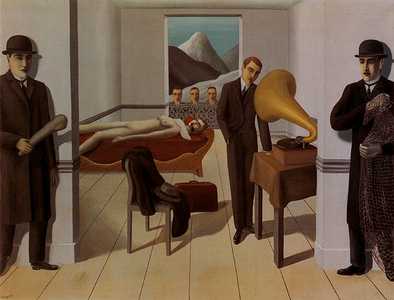Hi,
Today we'll look at one of Rene Magritte's best and most enigmatic early works. Several poem series have been written about his work. Ironically, the painting may be based on a poem by Paul Nouge.

The Threatened Murderer (L'assassin menacé)-1926
Most interpretations of The Threatened Murderer (1926-27) assume it is another of Magritte's paintings that captures the mystery of Fantomas. The painting is similar to a scene in Louis Feuillade's Fantômas film of 1912. It depicts two figures concealed by the doorway, armed with strange weapons, watching the "murderer," who is dressed in a business suit. Fantômas , the film, was based on the thirty-two-volume series written by Pierre Souvestre and Marcel Allain, each of whom wrote alternate chapters. Magritte was fascinated by the character of Fantômas who can pass unseen through matter, defy the establishment, and subvert its order.
Here's an analysis from Silvano Levy: Magritte's room, portraying the "stabbed mannequin," by its very complexity, sets up resonances that echo throughout Robbe-Grillet's text. It matters little that the latter's narrative contradicts details in the painting or adds to them, since the picture is subverted in the same manner that reality is contradicted. The three men looking in the window of The Threatened Assassin are not mentioned in Robbe-Grillet's text and the bowler-hatted man on the left, outside the door, is holding a baluster, not a club. Robbe-Grillet invents the sound of the phonograph that the young man inside the room is listening to and the narrator says it is replaying the woman's cry. This cry animates the painting and the naked mannequin which becomes a "real" woman. Although there is no sewing machine in the picture, the narrator tells us that the phonograph is the same age as the sewing machine, an allusion to Lautréamont's dissecting table where the fortuitous encounter of an umbrella and a sewing machine generates the ultimate spark of Surrealist beauty and activity.
The Beribboned Bomb By Robert James Belton: Belton relates that Magritte's painting may be based on the case of murderer Henry Landru who in 1922 was executed for murdering several women for their money. He also associates the painting to Fantômas who "always escapes and even passes through walls."
David Sylvester, Magritte's biographer suggests that this painting and the 1927 "Girl Eating Bird" were scripted from a set of violent and erotic poes by Paul Nouge finally published in 1956. The poems were written circa 1926-1927 when both Magritte and Nouge were working together designing catalogues for Samuels, a fur company. Here are some of the poetry lines:
[In the background, at the level of the window sil,
Four heads* stare at the murderer.
In the corridor on either side of the wide pen door,
Two men are approaching unable as yet to discern the spectacle.
They are ugly customers.
Crouching, they hug the wall.
One of them unfurls a huge net, the other brandishing a club.
All this will be called, "The Threatened Murderer."] Paul Nouge
*Magritte only had room for three heads- the fourth head is behind the suit of the murderer.
Certainly Magritte was fascinated by Fanatomas and this may have been an additional association. It appears that this was simply Magritte's painting of Paul Nouge's poem.